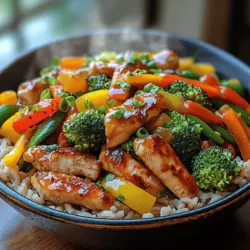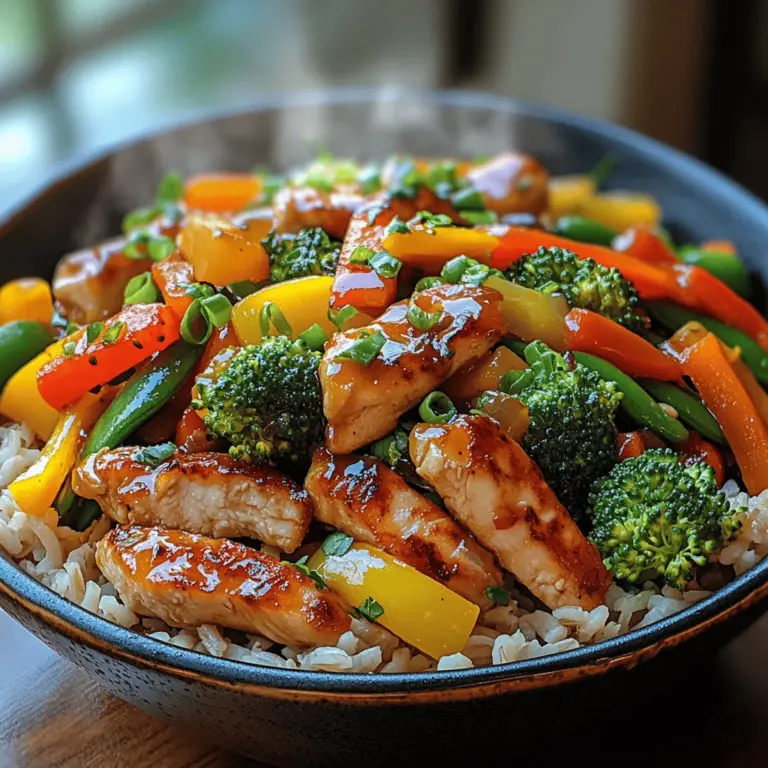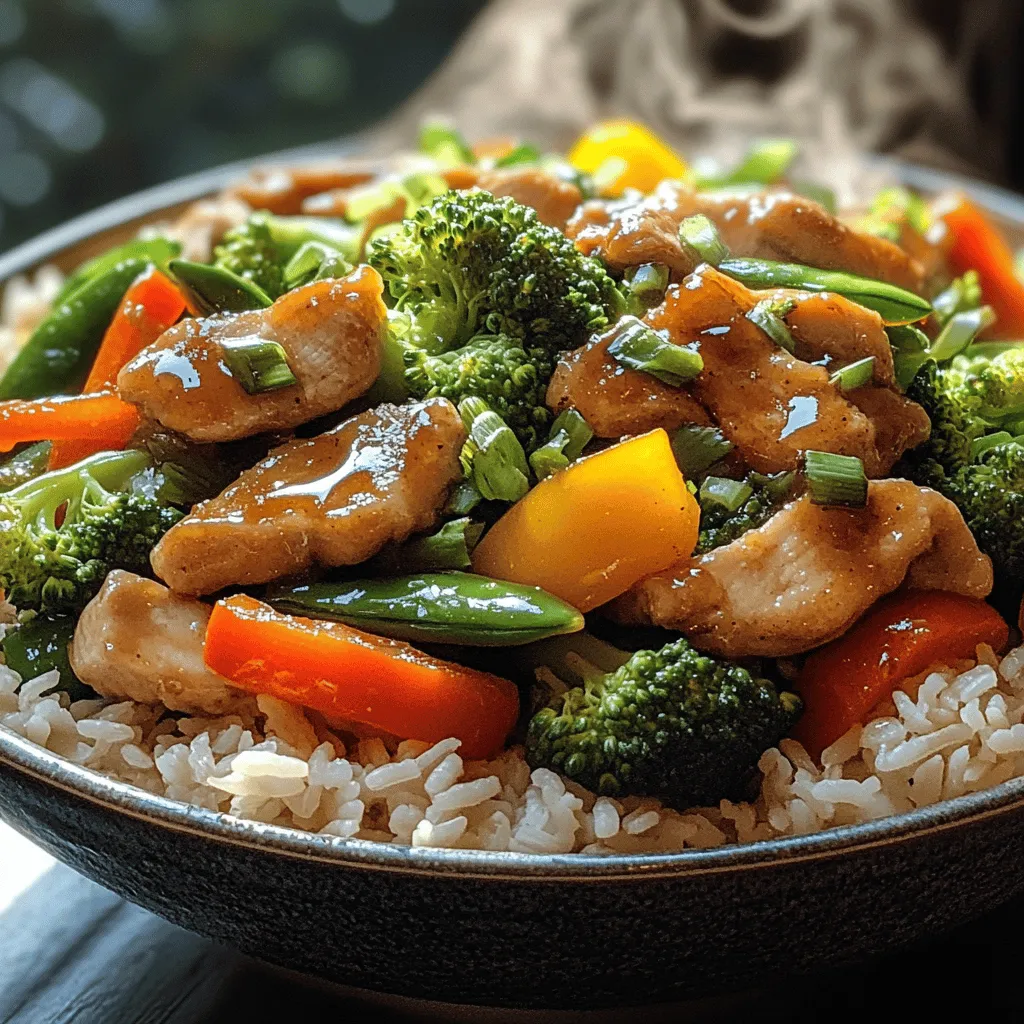Introduction
The Colorful Chicken Veggie Stir-Fry is a vibrant and nutritious dish that brings together tender chicken and a medley of fresh vegetables, all tossed in a flavorful sauce. This recipe not only boasts a dazzling array of colors but also provides a balanced nutritional profile that makes it a perfect meal for busy weeknights or leisurely weekend dinners. With its quick preparation time and adaptability, this stir-fry can easily cater to varying tastes and dietary needs, ensuring that everyone at the table will find something to love.
Stir-frying is more than just a cooking method; it embodies a culinary tradition that promotes healthful eating. By employing high heat and minimal cooking time, stir-frying helps retain the vibrant colors, textures, and nutrients of fresh produce, making it an ideal way to enjoy wholesome ingredients. In this article, we will delve into the numerous benefits of this dish, highlight its healthful ingredients, and provide a step-by-step process to create a delicious stir-fry that the whole family will appreciate.
Understanding the Appeal of Stir-Fry
The History of Stir-Fry Cooking
Stir-frying has roots in ancient Chinese cooking, where it was developed as a method to prepare food quickly over high heat. This technique not only maximizes flavor but also preserves the nutritional value of the ingredients. Traditionally, stir-frying involves a wok, a versatile cooking vessel that allows for even heat distribution and rapid cooking. Over the centuries, this method has spread globally, evolving to incorporate local ingredients and flavors, resulting in a wide array of stir-fry variations.
Why Stir-Fry is a Popular Cooking Method
The popularity of stir-fry can be attributed to several factors. First and foremost, it is an incredibly quick cooking method, often allowing meals to be prepared in under 30 minutes. This efficiency is particularly appealing in today’s fast-paced lifestyle, where many families seek healthy yet convenient meal options. Additionally, stir-frying is an excellent way to utilize leftovers or seasonal produce, making it a sustainable choice for home cooks. The ability to customize ingredients based on personal preferences further enhances its appeal, allowing for endless creativity in the kitchen.
Nutritional Benefits of Stir-Fry Dishes
Stir-fry dishes are inherently nutritious, primarily due to the combination of lean protein and a variety of colorful vegetables. Chicken, as the primary protein source in this recipe, provides essential amino acids necessary for muscle repair and overall health. Meanwhile, the diverse vegetables included in this stir-fry contribute vitamins, minerals, and fiber that are crucial for maintaining a balanced diet. The quick cooking process of stir-frying also helps retain the vitamins and minerals in the vegetables, making each bite not only flavorful but also healthful.
Ingredients Breakdown
Overview of Key Ingredients in the Recipe
To create a Colorful Chicken Veggie Stir-Fry, you’ll need a selection of core ingredients that work harmoniously to provide flavor, nutrition, and satisfaction. The main components of this dish include chicken, a variety of colorful vegetables, aromatics, and a selection of sauces and seasonings that elevate the overall taste.
Chicken: Protein Source and Health Benefits
Chicken is a lean source of protein that offers numerous health benefits. It is low in fat compared to red meats and provides essential nutrients such as B vitamins, phosphorus, and selenium, which support energy metabolism and immune function. When selecting chicken for your stir-fry, boneless, skinless chicken breast is often preferred due to its tenderness and quick cooking time. However, thighs can also be used for a richer flavor and juiciness.
Vegetables: Importance of Colorful Produce
Incorporating a variety of colorful vegetables not only enhances the visual appeal of your stir-fry but also maximizes its nutritional value. Each color often represents different phytochemicals and nutrients that contribute to overall health. The vibrant array of vegetables in this dish will include red and yellow bell peppers, broccoli, snap peas, and carrots, each adding their unique flavors and textures.
Red and Yellow Bell Peppers
Bell peppers are not only visually striking but also packed with nutrients. Red and yellow varieties are rich in vitamins A and C, which are essential for immune health and skin integrity. Their natural sweetness complements the savory elements of the stir-fry, making them a delightful addition.
Broccoli: A Nutrient Powerhouse
Broccoli is renowned for its health benefits, being a rich source of vitamins K and C, fiber, and numerous antioxidants. Its crunchy texture adds a satisfying bite to the stir-fry, while its slightly bitter flavor balances the sweetness of the other vegetables.
Snap Peas: Crunchy and Sweet
Snap peas are a delightful addition to any stir-fry. They offer a crisp texture and a touch of sweetness, making them a favorite among both children and adults. Packed with vitamins A, C, and K, as well as fiber, snap peas contribute to a well-rounded meal.
Carrots: A Touch of Sweetness
Carrots not only bring a vibrant orange hue to the dish but also provide natural sweetness and crunch. Rich in beta-carotene, which the body converts to vitamin A, carrots are known for promoting eye health and supporting the immune system.
Aromatics: The Role of Garlic and Ginger
To elevate the flavor of your stir-fry, aromatics such as garlic and ginger are essential. Garlic adds a pungent depth and has been linked to various health benefits, including improved heart health and immune support. Ginger, with its warm and spicy notes, enhances the dish’s complexity while also providing anti-inflammatory properties. Together, these aromatics create a fragrant base that infuses the entire stir-fry with rich flavor.
Sauces and Seasonings: Balancing Flavor
The right combination of sauces and seasonings can take your Colorful Chicken Veggie Stir-Fry from good to outstanding. A balance of savory, sweet, and tangy elements is crucial.
Low-Sodium Soy Sauce
Low-sodium soy sauce is a staple in many stir-fry recipes. It provides a savory umami flavor while minimizing sodium intake, making it a healthier choice for seasoning. This sauce will serve as the primary flavor enhancer in your stir-fry, complementing the natural tastes of the chicken and vegetables.
Honey vs. Maple Syrup for Sweetness
When it comes to adding sweetness, both honey and maple syrup can be excellent choices. Honey offers a distinct floral sweetness, while maple syrup brings a unique caramel-like flavor. Depending on your personal preference or dietary restrictions, you can choose either to balance the savory notes in your stir-fry.
The Use of Rice Vinegar
Rice vinegar adds a tangy brightness to your stir-fry, cutting through the richness of the sauce and enhancing the overall flavor profile. Its mild acidity provides a perfect contrast to the sweetness of the honey or maple syrup, creating a well-rounded dish.
Prep Work for a Perfect Stir-Fry
Chicken Preparation: Tips for Slicing and Seasoning
For optimal tenderness and flavor, it is essential to prepare the chicken properly. Start by cutting the chicken breast into thin, uniform strips. This ensures that the chicken cooks quickly and evenly. To enhance flavor further, consider marinating the chicken in a mixture of low-sodium soy sauce, garlic, and ginger for at least 15 minutes before cooking. This step infuses the meat with flavor and helps tenderize it, resulting in a more succulent stir-fry.
Vegetable Prep: Techniques for Cutting and Storing
Preparing the vegetables is just as crucial to achieving the perfect stir-fry. Begin by washing all produce thoroughly to remove any dirt or pesticides. Next, slice the bell peppers into thin strips, chop the broccoli into bite-sized florets, and cut the snap peas in half if they are large. Carrots can be julienned or sliced into rounds, depending on your preference.
To ensure that your stir-fry cooks evenly, it’s important to cut all vegetables into similar sizes. This allows for consistent cooking and helps maintain the desired texture. If you’re prepping in advance, store the washed and cut vegetables in airtight containers in the refrigerator, ideally using a paper towel to absorb excess moisture and keep them fresh.
With your ingredients prepped and ready, you are well on your way to creating a delicious and nutritious Colorful Chicken Veggie Stir-Fry. In the next section, we will explore the cooking process, detailing each step to ensure your stir-fry turns out flavorful and satisfying.
Importance of Having Everything Ready (Mise en Place)
Before diving into the cooking process, it’s essential to embrace the concept of mise en place, which translates to “everything in its place.” This French culinary technique involves gathering and preparing all your ingredients before you start cooking. For your Colorful Chicken Veggie Stir-Fry, having everything ready will streamline the cooking process and ensure that you can work efficiently without interruptions.
By measuring out your chicken, chopping your vegetables, and preparing your sauce, you will minimize the risk of burning ingredients or overcooking your chicken. Additionally, having everything prepped allows you to focus on the cooking techniques, ensuring that each component of your stir-fry is cooked to perfection.
Cooking Techniques for Stir-Fry
Choosing the Right Pan: Skillet vs. Wok
The choice of pan can significantly influence the outcome of your stir-fry. While both skillets and woks can be used for stir-frying, each has its unique advantages. A wok, with its sloped sides and large surface area, is specifically designed for high-heat cooking and allows for quick stir-frying. The shape helps to promote even cooking and gives you the ability to toss ingredients with ease.
On the other hand, if you don’t have a wok, a heavy skillet can also do the job. A cast iron skillet or non-stick frying pan can retain heat well, ensuring that your chicken and vegetables get that desirable sear. Just be sure to keep the heat high to replicate the effects of a wok.
Ideal Heat Levels: Understanding Your Stove
Stir-frying requires high heat, so understanding how your stove operates is crucial. Use the highest setting on your stove to achieve the searing temperature necessary for a successful stir-fry. Preheat your pan until it’s hot enough that a drop of water sizzles upon contact. If the oil starts to smoke, reduce the heat slightly before adding your ingredients.
Maintaining a consistent high heat throughout the cooking process allows you to cook your chicken and vegetables quickly, locking in their natural flavors and textures.
Cooking in Batches: Ensuring Even Cooking
To achieve the best results, consider cooking your chicken and vegetables in batches. Overcrowding the pan can lead to steaming rather than frying, resulting in a less desirable texture. Begin by cooking the chicken first, removing it from the pan once it’s cooked through, then add the vegetables in batches. This approach ensures that each ingredient has ample space to cook evenly, allowing for that classic stir-fry crunch.
Step-by-Step Cooking Instructions
Heating the Oil: The Foundation of Flavor
Start by selecting a high smoke point oil such as vegetable, canola, or peanut oil for your stir-fry. Pour approximately 2 tablespoons of oil into your preheated pan. Swirl the oil around to coat the surface evenly. This step is crucial as the oil not only prevents sticking but also infuses the dish with flavor.
Cooking the Chicken: Achieving the Perfect Sear
Once your oil is heated, add the diced chicken breast to the pan in a single layer. Allow the chicken to sear for about 5-6 minutes without stirring, ensuring it develops a golden-brown crust. Flip the chicken pieces and cook for an additional 2-3 minutes until fully cooked. Remove the chicken from the pan and set it aside, keeping it warm while you cook the vegetables.
Stir-Frying Vegetables: Maintaining Crunch and Color
In the same pan, add another tablespoon of oil if necessary, and increase the heat. Begin by adding your harder vegetables, such as bell peppers and broccoli, which take longer to cook. Stir-fry these for about 2-3 minutes until they begin to soften but are still crisp.
Next, add the softer vegetables such as snap peas and carrots, stirring continuously for another 2-3 minutes. The key here is to maintain a vibrant color in your vegetables, which indicates they are cooked perfectly while retaining their nutrients.
Combining Ingredients: Creating a Harmonious Dish
Once the vegetables are cooked, return the chicken to the pan. Pour your pre-prepared sauce over the chicken and vegetables, stirring to combine. Allow everything to cook together for another 2 minutes, enabling the flavors to meld beautifully.
Thickening the Sauce: When and How to Use Cornstarch
If you prefer a thicker sauce, now is the time to add a cornstarch slurry. Mix 1 tablespoon of cornstarch with 2 tablespoons of water until smooth. Pour this mixture into your stir-fry, stirring constantly until the sauce thickens. This step enhances the texture of the dish, allowing the sauce to cling to the chicken and vegetables.
Final Touches: Adding Green Onions and Adjusting Seasoning
Just before serving, stir in chopped green onions for a fresh flavor boost. Taste and adjust the seasoning if necessary, adding more soy sauce, salt, or pepper according to your preference. Once satisfied, remove the stir-fry from heat and prepare to serve.
Serving Suggestions
Best Bases: Brown Rice vs. Quinoa
When it comes to serving your Colorful Chicken Veggie Stir-Fry, consider pairing it with a healthy base. Brown rice is a classic choice, providing a nutty flavor and chewy texture that complements the stir-fry perfectly. Alternatively, quinoa offers a gluten-free, protein-rich option that elevates the meal’s nutritional value.
Creative Serving Ideas: Bowls, Wraps, or Lettuce Cups
For a fun twist, consider serving your stir-fry in innovative ways. Create delicious bowls by layering your base of brown rice or quinoa with the stir-fried chicken and veggies, topping it with sesame seeds and sliced green onions.
You could also make wraps using whole wheat tortillas or rice paper, filling them with the stir-fry mixture. For a lighter option, use large lettuce leaves to create lettuce cups, perfect for a refreshing bite.
Pairing Options: What Goes Well with Stir-Fry?
To elevate your meal, consider serving additional sides that complement your stir-fry. A simple cucumber salad dressed with rice vinegar adds a crunchy, refreshing element. Alternatively, steamed dumplings or spring rolls can provide a delightful contrast while enhancing the overall dining experience.
Nutritional Analysis
Caloric Breakdown: Understanding the Nutritional Value
The Colorful Chicken Veggie Stir-Fry is not only delicious but also a nutritious meal option. A single serving typically contains around 400-500 calories, depending on portion sizes and added ingredients. The dish is high in protein from the chicken and packed with vitamins from the variety of vegetables used.
Health Benefits of Each Ingredient
Each ingredient in this stir-fry contributes unique health benefits. Chicken breast is a lean protein source, essential for muscle repair and growth. Vegetables like bell peppers and broccoli are rich in antioxidants and vitamins A, C, and K, which support immune function and overall health. Moreover, using whole grains like brown rice or quinoa provides fiber, enhancing digestive health.
How This Dish Fits into Various Diets (e.g., Gluten-Free, Dairy-Free)
This stir-fry is incredibly versatile and can be easily adapted to fit various dietary preferences. By using gluten-free soy sauce or tamari, you can make this dish suitable for those with gluten sensitivities. Additionally, it is naturally dairy-free, making it an excellent choice for lactose-intolerant individuals.
Conclusion
The Colorful Chicken Veggie Stir-Fry is more than just a quick meal; it’s an opportunity to infuse your diet with essential nutrients while enjoying a burst of flavors. With its simple preparation and adaptability, this dish can easily become a staple in your weekly meal planning. Whether you’re looking to impress family or simply want a satisfying dinner option, this stir-fry is sure to delight. Embrace the joy of cooking and enjoy the health benefits that come with it. So, gather your ingredients, follow these detailed steps, and savor every bite of this vibrant, nutritious stir-fry!


